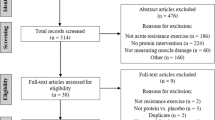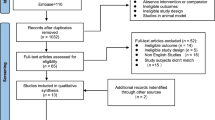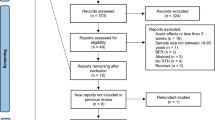Abstract
The present systematic review and meta-analysis aimed to compare the impact of exercise intensity and mode (high-intensity interval exercise-HIIE or sprint interval exercise-SIE versus moderate-intensity continuous exercise-MICE) on post-exercise ad libitum energy intake. The studies were required to have at least two exercise conditions (HIIE or SIE vs MICE). Overall, 642 manuscripts were initially identified and 17 met the eligibility criteria. The random effect meta-analysis did not reveal differences for absolute energy intake (28 pairwise comparisons) between HIIE (p = 0.54; 95% Confidence Interval – CI: −0.14 to 0.26; 22 pairwise comparisons) or SIE (p = 0.08; 95% CI −0.65 to 0.03; 6 pairwise comparisons) versus MICE, neither for relative energy intake (p = 0.97; 95% CI: −0.35 to 0.10 for HIIE; p = 0.28; 95% CI: −1.03 to 0.06 for SIE) with five and one pairwise comparisons, respectively. Subgroup analyses for methods to evaluate ad libitum energy intake, body mass, sex, volume, and timing of exercise were non-significant. Inspecting each study, two pairwise comparisons reported lower post-exercise absolute energy intake in HIIE compared to control (CRTL), and three pairwise comparisons reported lower absolute energy intake after SIE compared to MICE. None pairwise comparison reported differences between protocols (HIIE or SIE versus MICE) for relative energy intake. In conclusion, the meta-analysis did not show differences between protocols for absolute and relative energy intake; five pairwise comparisons from 28 demonstrated lower absolute energy intake in HIIE or SIE compared to CRTL or MICE. Further studies are needed to address the key relevant variables in which exercise intensity and mode may impact energy intake.
This is a preview of subscription content, access via your institution
Access options
Subscribe to this journal
Receive 12 print issues and online access
$259.00 per year
only $21.58 per issue
Buy this article
- Purchase on Springer Link
- Instant access to full article PDF
Prices may be subject to local taxes which are calculated during checkout








Similar content being viewed by others
References
Charlot K, Chapelot D. Comparison of energy-matched high-intensity interval and moderate-intensity continuous exercise sessions on latency to eat, energy intake, and appetite. Appl Physiol Nutr Metab. 2019;44:665–73. https://doi.org/10.1139/apnm-2018-0485.
Deighton K, Barry R, Connon CE, Stensel DJ. Appetite, gut hormone and energy intake responses to low volume sprint interval and traditional endurance exercise. Eur J Appl Physiol. 2013;113:1147–56. https://doi.org/10.1007/s00421-012-2535-1.
Deighton K, Karra E, Batterham RL, Stensel DJ. Appetite, energy intake, and PYY3-36 responses to energy-matched continuous exercise and submaximal high-intensity exercise. Appl Physiol Nutr Metab. 2013;38:947–52. https://doi.org/10.1139/apnm-2012-0484.
Martins C, Stensvold D, Finlayson G, Holst J, Wisloff U, Kulseng B, et al. Effect of moderate- and high-intensity acute exercise on appetite in obese individuals. Nutrients 2015;47:40–8. https://doi.org/10.3390/nu10070889.10.1249/mss.0000000000000372.
Panissa VLG, Julio UF, Hardt F, Kurashima C, Lira FS, Takito MY, et al. Effect of exercise intensity and mode on acute appetite control in men and women. Appl Physiol Nutr Metab. 2016;41:1083–91. https://doi.org/10.1139/apnm-2016-0172.
Schubert MM, Desbrow B, Sabapathy S, Leveritt M. Acute exercise and subsequent energy intake. A meta-analysis. Appetite. 2013;63:92–104. https://doi.org/10.1016/j.appet.2012.12.010.
Crabtree DR, Blannin AK. Effects of exercise in the cold on Ghrelin, PYY, and food intake in overweight adults. Med Sci Sports Exerc. 2015;47:49–57. https://doi.org/10.1249/mss.0000000000000391.
Faure C, Charlot K, Henri S, Hardy-Dessources MD, Hue O, Antoine-Jonville S. Effect of heat exposure and exercise on food intake regulation: a randomized crossover study in young healthy men. Metab Clin Exp. 2016;65:1541–9. https://doi.org/10.1016/j.metabol.2016.07.004.
Shorten AL, Wallman KE, Guelfi KJ. Acute effect of environmental temperature during exercise on subsequent energy intake in active men. Am J Clin Nutr. 2009;90:1215–21. https://doi.org/10.3945/ajcn.2009.28162.
Albert MH, Drapeau V, Mathieu ME. Timing of moderate-to-vigorous exercise and its impact on subsequent energy intake in young males. Physiol Behav. 2015;151:557–62. https://doi.org/10.1016/j.physbeh.2015.08.030.
Fillon A, Mathieu ME, Boirie Y, Thivel D. Appetite control and exercise: does the timing of exercise play a role? Physiol Behav. 2020;218:112733. https://doi.org/10.1016/j.physbeh.2019.112733.
Maraki M, Tsofliou F, Pitsiladis YP, Malkova D, Mutrie N, Higgins S. Acute effects of a single exercise class on appetite, energy intake and mood. Is there a time of day effect? Appetite. 2005;45:272–8. https://doi.org/10.1016/j.appet.2005.07.005.
Panissa VLG, Julio UF, St-Pierre DH, Tavares da Silva Gomes A, Caldeira RS, Lira FS, et al. Timing of high-intensity intermittent exercise affects ad libitum energy intake in overweight inactive men. Appetite. 2019;143:104443. https://doi.org/10.1016/j.appet.2019.104443.
Broom DR, Miyashita M, Wasse LK, Pulsford R, King JA, Thackray AE, et al. Acute effect of exercise intensity and duration on acylated ghrelin and hunger in men. J Endocrinol. 2017;232:411–22. https://doi.org/10.1530/joe-16-0561.
Holliday A, Blannin A. Appetite, food intake and gut hormone responses to intense aerobic exercise of different duration. J Endocrinol. 2017;235:193–205. https://doi.org/10.1530/joe-16-0570.
Kawano H, Mineta M, Asaka M, Miyashita M, Numao S, Gando Y, et al. Effects of different modes of exercise on appetite and appetite-regulating hormones. Appetite. 2013;66:26–33. https://doi.org/10.1016/j.appet.2013.01.017.
Keating SE, Johnson NA, Tremblay A, Simoneau JA, Bouchard C. Impact of exercise intensity on body fatness and skeletal muscle metabolism. Int J Sports Med. 1994;43:814–8. https://doi.org/10.1007/s40279-019-01167-w.10.1016/0026-0495(94)90259-3.
Trapp EG, Chisholm DJ, Freund J, Boutcher SH. The effects of high-intensity intermittent exercise training on fat loss and fasting insulin levels of young women. Int J Obes. 2008;32:684–91. https://doi.org/10.1038/sj.ijo.0803781.
Boutcher SH. High-intensity intermittent exercise and fat loss. J Obes. 2011;2011:868305. https://doi.org/10.1155/2011/868305.
Andreato LV, Esteves JV, Coimbra DR, Moraes AJP, de Carvalho T. The influence of high-intensity interval training on anthropometric variables of adults with overweight or obesity: a systematic review and network meta-analysis. Obes Rev. 2019;20:142–55.
Keating SE, Johnson NA, Mielke GI, Coombes JS. A systematic review and meta-analysis of interval training versus moderate-intensity continuous training on body adiposity. Obes Rev. 2017;18:943–64. https://doi.org/10.1111/obr.12536.
Sultana RN, Sabag A. The effect of low-volume high-intensity interval training on body composition and cardiorespiratory fitness: a systematic review and meta-analysis. Int J Sports Med. 2019;49:1687–721. https://doi.org/10.1007/s40279-019-01167-w.
Fothergill E, Guo J, Howard L, Kerns JC, Knuth ND, Brychta R, et al. Persistent metabolic adaptation 6 years after “The Biggest Loser” competition. Obes. 2016;24:1612–9. https://doi.org/10.1002/oby.21538.
Fedewa MV, Hathaway ED, Williams TD, Schmidt MD. Effect of exercise training on non-exercise physical activity: a systematic review and meta-analysis of randomized controlled trials. Int J Sports Med. 2017;47:1171–82. https://doi.org/10.1007/s40279-016-0649-z.
Beaulieu K, Hopkins M, Blundell J, Finlayson G. Does habitual physical activity increase the sensitivity of the appetite control system? A systematic review. Int J Sports Med. 2016;46:1897–919. https://doi.org/10.1007/s40279-016-0518-9.
Panissa VL, Fukuda DH, Staibano V, Marques M, Franchini E. Magnitude and duration of excess of post-exercise oxygen consumption between high-intensity interval and moderate-intensity continuous exercise: a systematic review. Obes Rev. 2020;22:e13099.
Moher D, Shamseer L, Clarke M, Ghersi D, Liberati A, Petticrew M, et al. Preferred reporting items for systematic review and meta-analysis protocols (PRISMA-P) 2015 statement. Syst Rev. 2015;4:1. https://doi.org/10.1186/2046-4053-4-1.
Buchheit M, Laursen PB. High-intensity interval training, solutions to the programming puzzle. Int J Sports Med. 2013;43:927–54.
Beer NJ, Dimmock JA, Jackson B, Guelfi KJ. Interactions of sprint interval exercise and psychological need-support on subsequent food intake among physically inactive men and women. Appl Physiol Nutr Metab. 2020;45:835–44. https://doi.org/10.1139/apnm-2019-0672.
Higgins JP, Altman DG, Gøtzsche PC, Jüni P, Moher D,Oxman AD, et al. The Cochrane Collaboration’s tool for assessing risk of bias in randomised trials. BMJ. 2011;343:d5928.
Higgins JP, Thompson SG, Deeks JJ, Altman DG. Measuring inconsistency in meta-analyses. BMJ. 2003;327:557–560.
Islam H, Townsend LK, McKie GL, Medeiros PJ, Gurd BJ, Hazell TJ. Potential involvement of lactate and interleukin-6 in the appetite-regulatory hormonal response to an acute exercise bout. J Appl Physiol. 2017;123:614–23. https://doi.org/10.1152/japplphysiol.00218.2017.
Poon ET, Sheridan S, Chung AP, Wong SH. Age-specific affective responses and self-efficacy to acute high-intensity interval training and continuous exercise in insufficiently active young and middle-aged men. J Exerc Sci Fit. 2018;16:106–11. https://doi.org/10.1016/j.jesf.2018.09.002.
Dupuit M, Boscaro A, Bonnet A, Bouillon P, Bruno P, Morel C, et al. Acute metabolic responses after continuous or interval exercise in post-menopausal women with overweight or obesity. Scand J Med Sci Sports. 2020;30:2352–63. https://doi.org/10.1111/sms.13814.
Matos VAF, de Souza DC, Browne RAV, Dos Santos VOA, Medeiros ÍF, do Nascimento PRP, et al. A single session of low-volume high-intensity interval and moderate-intensity continuous exercise elicits a transient reduction in ghrelin levels, but not in post-exercise energy intake in obese men. Arch Endocrinol Metab. 2020. https://doi.org/10.20945/2359-3997000000308.
Matos VAF, Souza DC. Acute effects of high-intensity interval and moderate-intensity continuous exercise on GLP-1, appetite and energy intake in obese men: a crossover trial. Nutrients. 2018;10. https://doi.org/10.3390/nu10070889.
da Silva Gomes AT, Julio UF, Takito MY, Alves ED, Fukuda DH, Franchini E, et al. Energy intake post-exercise is associated with enjoyment independently of exercise intensity. Sport Sci Health. 2018;14:511–6.
Larsen P, Marino F, Melehan K, Guelfi KJ, Duffield R, Skein M. High-intensity interval exercise induces greater acute changes in sleep, appetite-related hormones, and free-living energy intake than does moderate-intensity continuous exercise. Appl Physiol Nutr Metab. 2019;44:557–66. https://doi.org/10.1139/apnm-2018-0503.
Linoby A, Jumat MAN, Nordin AS, Za'don NHA, Kusrin J, Mud Puad SMS. Acute moderate and high-intensity endurance exercise suppresses ad-libitum energy intake in obese males. Pertanika J Sci Technol. 2020;28:279–92.
Shamlan G, Bech P, Robertson MD, Collins AL. Acute effects of exercise intensity on subsequent substrate utilisation, appetite, and energy balance in men and women. Appl Physiol Nutr Metab. 2017;42:1247–53. https://doi.org/10.1139/apnm-2017-0280.
Sim AY, Wallman KE, Fairchild TJ, Guelfi KJ. High-intensity intermittent exercise attenuates ad-libitum energy intake. IJO. 2014;38:417–22. https://doi.org/10.1038/ijo.2013.102.
Fillon A, Beaulieu K, Miguet M, Bailly M, Finlayson G.JulianV, et al. Does exercising before or after a meal affect energy balance in adolescents with obesity? Nutr Metab Cardiovasc Dis. 2020;30:1196–200.
Fillon A, Mathieu ME, Masurier J, Roche J, Miguet M, Khammassi M, et al. Effect of exercise-meal timing on energy intake, appetite and food reward in adolescents with obesity: The TIMEX study. Appetite. 2020;146:104506. https://doi.org/10.1016/j.appet.2019.104506.
Gerosa-Neto J, Panissa VLG, Monteiro PA, Inoue DS, Ribeiro JPJ, Figueiredo C, et al. High- or moderate-intensity training promotes change in cardiorespiratory fitness, but not visceral fat, in obese men: A randomised trial of equal energy expenditure exercise. RESPNB. 2019;266:150–5. https://doi.org/10.1016/j.resp.2019.05.009.
Dorling J, Broom DR, Burns SF, Clayton DJ, Deighton K, James LJ, et al. Acute and chronic effects of exercise on appetite, energy intake, and appetite-related hormones: the modulating effect of adiposity, sex, and habitual physical activity. Nutrients. 2018;10:1140.
George VA, Morganstein A. Effect of moderate intensity exercise on acute energy intake in normal and overweight females. Appetite. 2003;40:43–6.
Kissileff HR, Pi-Sunyer F, Segal K, Meltzer S, Foelsch PA. Acute effects of exercise on food intake in obese and nonobese women. Am J Clin Nutr. 1990;52:240–5.
Douglas JA, King JA, Clayton DJ, Jackson AP, Sargeant JA, Thackray AE, et al. Acute effects of exercise on appetite, ad libitum energy intake and appetite-regulatory hormones in lean and overweight/obese men and women. IJO. 2017;41:1737–44. https://doi.org/10.1038/ijo.2017.181.
Unick JL, Otto AD, Goodpaster BH, Helsel DL, Pellegrini CA, Jakicic JM. Acute effect of walking on energy intake in overweight/obese women. Appetite. 2010;55:413–9. https://doi.org/10.1016/j.appet.2010.07.012.
Finlayson G, Bryant E, Blundell JE, King NA. Acute compensatory eating following exercise is associated with implicit hedonic wanting for food. Physiol Behav. 2009;97:62–7. https://doi.org/10.1016/j.physbeh.2009.02.002.
Jokisch E, Coletta A, Raynor HA. Acute energy compensation and macronutrient intake following exercise in active and inactive males who are normal weight. Appetite. 2012;58:722–9. https://doi.org/10.1016/j.appet.2011.11.024.
Rocha J, Paxman J, Dalton C, Winter E, Broom D. Effects of an acute bout of aerobic exercise on immediate and subsequent three-day food intake and energy expenditure in active and inactive pre-menopausal women taking oral contraceptives. Appetite. 2015;89:183–91. https://doi.org/10.1016/j.appet.2015.02.005.
Blundell J, De Graaf C, Hulshof T, Jebb S, Livingstone B, Lluch A, et al. Appetite control: methodological aspects of the evaluation of foods. Obes Rev. 2010;11:251–70.
King JA, Wasse LK, Ewens J, Crystallis K, Emmanuel J, Batterham RL, et al. Differential acylated ghrelin, peptide YY3-36, appetite, and food intake responses to equivalent energy deficits created by exercise and food restriction. J Clin Endocrinol Metab. 2011;96:1114–21. https://doi.org/10.1210/jc.2010-2735.
Metcalfe RS, Koumanov F, Ruffino JS, Stokes KA, Holman GD, Thompson D, et al. Physiological and molecular responses to an acute bout of reduced-exertion high-intensity interval training (REHIT). Eur J Appl Physiol. 2015;115:2321–34. https://doi.org/10.1007/s00421-015-3217-6.
Horner KM, Schubert MM, Desbrow B, Byrne NM, King NA. Acute exercise and gastric emptying: a meta-analysis and implications for appetite control. Int J Sports Med. 2015;45:659–78. https://doi.org/10.1007/s40279-014-0285-4.
Janssen P, Vanden Berghe P, Verschueren S, Lehmann A, Depoortere I, Tack J. Review article: the role of gastric motility in the control of food intake. J Appl Physiol. 2011;33:880–94. https://doi.org/10.1152/japplphysiol.00218.2017.10.1111/j.13652036.2011.04609.x.
Acknowledgements
PAQR was supported by FAPESP (2018/17239-0). VLGP was supported by Coordenação de Aperfeiçoamento de Pessoal de Nível Superior (CAPES) (88887.336103/2019-00). EF was supported by Conselho Nacional de Desenvolvimento Científico e Tecnológico (CNPq) grant 301003/2019-0. RS was supported by Coordenação de Aperfeiçoamento de Pessoal de Nível Superior (88887.463962/2019-00).
Author information
Authors and Affiliations
Contributions
VLGP and EF conceived and designed the study. PAQR, VLGP, FER, FSL and RS analyzed the data. PAQR, VGLP, RS, MYT, FSL, FER and EF wrote the paper. All authors read and provided critical feedback on the manuscript before approving.
Corresponding author
Ethics declarations
Competing interests
The authors declare no competing interests.
Additional information
Publisher’s note Springer Nature remains neutral with regard to jurisdictional claims in published maps and institutional affiliations.
Supplementary information
Rights and permissions
About this article
Cite this article
Rossi, P.A.Q., Panissa, V.L.G., Silveira, R. et al. Post-exercise energy intake: do the intensity and mode of exercise matter? A systematic review and meta-analysis comparing high-intensity interval with moderate-intensity continuous protocols. Eur J Clin Nutr 76, 929–942 (2022). https://doi.org/10.1038/s41430-021-01026-w
Received:
Revised:
Accepted:
Published:
Issue Date:
DOI: https://doi.org/10.1038/s41430-021-01026-w



